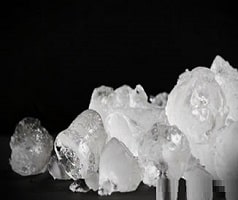Examples of Heat Energy
We express that what are the examples of heat energy? with definition of heat or temperature, heat and dilation, heat transfer mechanisms and heat springs in detail.
What is Heat? examples of heat energy
The Heat is one of the forms of energy. It consists of the transfer of energy from a body that has a higher temperature to a lower one. It is, in fact, this difference in temperatures that drives the transfer.
When heat is communicated to a body, its molecules move faster and the body is warmer than before. This thermal effect is called temperature , and it is the average kinetic energy of the molecules; while the amount of heat contained in a body is the sum of the energies of all its molecules (kinetic energy of translation and internal energy of rotation and vibration.
Temperature examples of heat energy
Temperatures or degrees of heat are measured by thermometers. The most common thermometer is the Mercury thermometer. The fixed points of a thermometer are the freezing point and the boiling point of water at a barometric pressure of 760mmHg.
In the centigrade or Celsius thermometer the freezing point of water corresponds to zero 0 ° C and the boiling point to 100 ° C. The space between the fixed points is divided into 100 equal parts called degrees . On the Fahrenheit thermometer the freezing point of water reads 32 ° F and the boiling point 212 ° F; the space in between is divided into 180 equal parts or degrees.
To reduce degrees Celsius to degrees Fahrenheit, multiply degrees Celsius by 1.8 and add 32. The inverse transformation from degrees Fahrenheit to degrees Celsius is done by subtracting 32 from the number of degrees Fahrenheit and dividing the remainder by 1.8.
While temperature is measured in degrees, heat is measured in the metric system in calories and in the English system in British Thermal Units. examples of heat energy
The Calorie is the amount of heat necessary to raise the temperature of 1 gram of water by 1 ° C.
The Brittish Thermal Unit (BTU) is the amount of heat needed to raise the temperature of 1 pound of water by 1 ° F.
(1 BTU = 252 calories)
Heat and Dilation
When a mass is heated, the molecular motion increases and, consequently, the temperature rises. However, this increase in molecular motion further separates the molecules from each other, and this dispersion determines the increase in volume of the mass. examples of heat energy
In general, all bodies expand with increasing temperature . This change affects all forms of matter: solids, liquids and gases. Solids and liquids do not experience the same expansion with a certain increase in temperature.
In the case of a solid, the expansion can be expressed in the sense of increasing its length (bars, rods), its surface (sheets) and, in general, its volume.
The expansion experienced by the unit of length when its temperature increases 1 degree centigrade, is called the coefficient of linear expansion.
In liquids, expansion generally refers to their change in volume, and analogous expansion is called the coefficient of cubic expansion.
Different solids and liquids have different coefficients of expansion, and these are not uniform at all temperatures.
Unlike solids and liquids, all gases have the same coefficient of expansion, uniform at all temperatures. The value of the cubic expansion coefficient of gases is 1 / 273.16 of their volume at 0 ° C. That is, if we take a liter of gas at 0 ° C and raise its temperature by 1 °, the new volume will be 1 / 273.16 greater than the volume at 0 ° C.
Raising the temperature to 55 ° C, the new volume will be 55 / 273.16 greater than the original one.
Heat Transfer Mechanisms
Energy in the form of heat can be transmitted in three fundamental ways: Conduction, Convection and Radiation.
Conduction: It is when the Heat is transmitted through a material that is capable of doing it and taking it from one point to another. Metals are the best conductors of heat.
Convection: It is the transfer of Heat through the movement of a fluid. As in a pot containing boiling water; the lower heat heats the water, which, when stirred further, will tend to rise. Thus, naturally and inevitably, the heat will rise to heat the upper layers of water.
Radiation: It is the form of heat transfer that consists of electromagnetic waves of the infrared order. The sun emits these types of waves, among many others, thus taking charge of heating the planet.

Heat Springs
The most important source of heat is the Sun. It is estimated that the solar heat that reaches the earth’s crust in half a day is equivalent to that which would be produced by burning a trillion barrels of oil, that is, all the oil stored in the Land.
Another source of heat is the inner part of the Earth heated to a high temperature, which manifests itself on the surface in the form of volcanoes, hot springs and geysers. These can be called direct sources of heat .
There are several indirect sources of heat energy . For example, the hydraulic force of waterfalls, tides, and high-altitude bodies of water can be converted into electrical energy, and this, in turn, into heat.
The chemical action is another important heat generator. To obtain this we have to burn wood, coal, oil and combustible gases.
Some forms of solid fuel, such as charcoal, anthracite, and coke, turn white when burned and give off heat and light without producing a noticeable flame.
Others, such as wood, lignite, tar and wax, and also liquids such as petroleum and alcohol, burn with a flame, which is the result of the combustion of the gases that are given off from the fuel by the heat of the reaction. All gases burn with a flame.
Examples of Heat
The flame in the domestic stove transfers the energy from the fuel to the container where it is cooked.
The Sun is a huge cluster of reactions that emit radiation towards the planet, raising its temperature.
When Sulfuric Acid is added to Water, it will emit heat energy to the environment.
The iron transfers heat to the fabric to soften it. It is the metal plate that is in charge of unwrinkling.
Chemical action is an important heat generator.
The inner part of the Earth heated to high temperatures, which manifests itself on the surface in the form of volcanoes, hot springs and geysers.
Metals are the best conductors of heat.
In a pot containing boiling water, the lower heat heats the water, which will tend to rise when stirred further.
The motor of a car, in addition to mechanical work, emits heat.
In the Evaporators the diluted solution is heated to separate its volatile solvent. examples of heat energy

